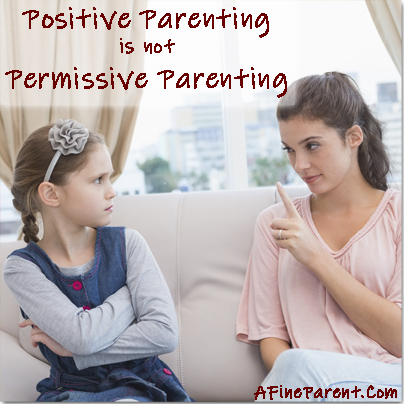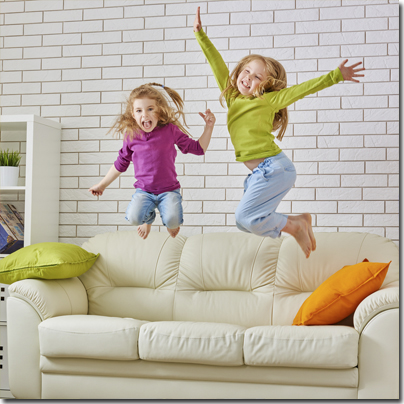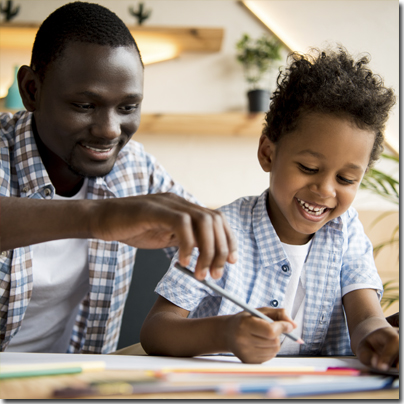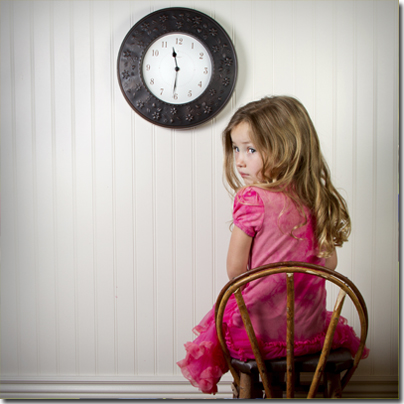 Imagine this –
Imagine this –
A three-year-old boy gets angry while playing a game with his friends and hits another child hard and pushes him down.
The mom comes and gives the aggressive child a hug and asks him politely not to hit his friends, and then returns to her table where she was sitting.
A few moments later, the child repeats the offense.
These are the kinds of scenarios dreamed up by those who say positive parenting doesn’t work.
At the heart of their disdain for positive parenting is the ill-conceived belief that positive parenting is permissive parenting.
They believe that positive parents fail to set boundaries, let children make and break the rules, and decline any discipline whatsoever.
And they think we try to solve every problem with a hug, are afraid of upsetting our snowflakes, and just want to be our child’s friend.
I’m sure you’ve heard this rhetoric before.
Let’s set the record straight and define what positive parenting really is and how it differs from permissive parenting.
First, it may be a good idea to discuss the three main parenting styles.
Authoritarian – This style combines low warmth and high control. It is characterized by frequent use of punishment, very limited flexibility, high expectations, and one-way communication from parent to child. This type of parenting is associated with poor child outcomes, including rebelliousness, hostility, and antisocial behavior.
Permissive – Permissive parents exhibit lots of warmth and very little control. They are lax on rules and discipline. They are often loving but tend to allow their kids to sort things out for themselves and they do not lead well and are uncomfortable with setting limits. Research has found links between excessive indulgence and children’s decreased social competence, bossiness, low self-control, and failure to learn emotional control.
Authoritative – This style displays both high warmth and high expectations. These parents are nurturing and kind but also set limits which they explain clearly and hold boundaries. They also engage in frequent communication with their children. This parenting style has the best child outcomes, raising kids with high levels of moral reasoning, prosocial behaviors, and good self-control.
Positive parenting falls in the authoritative category.
Let’s explore a few scenarios to show the types of responses you’d see from different parenting styles so you can see how positive parenting differs from the rest.
REGARDING LIMITS
 Positive parents do set appropriate limits for their children. We must not shrug off our duties to keep our children safe and to provide boundaries that children need.
Positive parents do set appropriate limits for their children. We must not shrug off our duties to keep our children safe and to provide boundaries that children need.
The difference with positive parenting is not the lack of limits, but the way in which limits are set and enforced. Positive parents set limits with a basic understanding of child development and enforce with kindness and firmness.
Now let’s look at these styles in action in a common parenting scenario.
Scenario
Your 18 month old is a little explorer and has mastered climbing the chair and then up onto the table.
Authoritarian parent’s reaction:
Sternly, “Do NOT climb up there again!” She is forcefully removed and sat in a time out chair in the corner.
Permissive parent’s reaction:
“Honey, I told you not to climb. Please get down.” No action is taken. “Honey, I asked you to get down. You might fall.” At this point, the permissive parent may take action to get the child down, but no limits are set.
Positive parent’s reaction:
The first time your child attempts to climb on the table, you intervene, saying “Climbing is fun! Let’s find a safe place for you to climb. This table is not safe.” Let her climb over some couch cushions, if she wants.
Climbing itself is not a misbehavior. The goal is to keep her safe and teach her what is appropriate. So the next time she heads for the table, immediately and gently take her from the table, repeating the above.
If she gets upset, acknowledge her upset. “I see you’re mad. You want to climb, but that isn’t safe. Let’s go play over here.” Redirect her to a new activity if needed.
The positive parent set the limit, stuck to the limit by not allowing the child to climb on the table, but showed the child an appropriate outlet and empathized with her feelings. This shows high warmth along with high expectations and limits.
REGARDING LEADERSHIP
 Another misconception is that positive parents treat children like little adults and allow them too much freedom by not stepping into the leadership role in the relationship.
Another misconception is that positive parents treat children like little adults and allow them too much freedom by not stepping into the leadership role in the relationship.
While children do deserve to be treated with the same respect and dignity afforded to older humans, we realize they do not have the brain of an adult. They depend on their parents for leadership and guidance. No child wants to be the leader, it’s too much responsibility for them.
Let’s take a look at another scenario showing how a positive parent shows leadership.
Scenario
You have a 5 year old and a 2 year old, and you have to go to the store to pick up a few items. Your 5 year old is begging for a new toy, and your 2 year old is late for his nap and is cranky.
Authoritarian parent’s reaction:
To the 5 year old: “I told you before we came that you couldn’t have a new toy. If you ask one more time, you’ll get it when we get home.” To the cranky 2 year old, “Will you stop whining? We’ll be leaving in just a minute. I can’t take you kids anywhere!”
Permissive parent’s reaction:
Buys both kids a new toy AND a sucker to appease them until the shopping is done.
Positive parent’s reaction:
To the 5 year old, “That is such a cool toy! I wish I could buy it for you. I see how much you want it. It’s disappointing when we can’t get something we want right away. I’ll add it to your wish list!” Empathize with his disappointment. We all get disappointed when we can’t get stuff we want.
To the 2 year old, “I know you’re tired. Will you be my helper? I’m looking for bananas. Do you see any bananas?” It’s also not a bad idea to carry things in your purse that you know your child likes. My own son loves to draw, so if I give him paper and a pencil anywhere, he’s happy.
The positive parent showed leadership by being prepared and skillfully using tools from the positive parenting toolkit.
Fantasizing with the child (“That is a cool toy, I wish I could buy it for you”), using empathy (“I see how much you want it. It’s disappointing when we can’t get something we want right away” and “I know you’re tired”) and distraction (“Will you be my helper? I’m looking for bananas”) are all great ways to show high warmth, while holding on to the expectations that you can go shopping with your kids without having to buy them something every single time.
REGARDING DISCIPLINE
 In Positive Parenting, discipline means “to teach” not “to punish.” Therefore, we are always disciplining our children!
In Positive Parenting, discipline means “to teach” not “to punish.” Therefore, we are always disciplining our children!
We are mindful that every interaction with them teaches them something and every interaction they see us have with others and that they have with others teaches them something. Children are always learning from their environment and caretakers, so the words and actions we use day in and day out matter.
Let’s look at the discipline styles of authoritarian, permissive, and positive parents.
Scenario
Your 2 year old has started hitting. At a play date, someone snatches her toy, and she whacks the snatcher with a right hand.
Authoritarian parent’s reaction:
Spanks the child, saying “You know better than to hit!”
Permissive parent’s reaction:
Ignores the hitting, blames the other child, or nonchalantly says, “We don’t hit” from across the room.
Positive parent’s reaction:
Goes to child immediately and removes her from the situation. Gets down on her level and says, “You’re mad! She took your toy and you got mad! Hitting hurts. Sit here with me until you’re feeling better.”
Have her remain on your lap or sit next to you. Empathize with her emotions and help her get regulated. When she is calm, tell her again that hitting hurts, and she may not hit. If you want to remain at the play date, watch closely and try to intervene before anything escalates to something physical. An ounce of prevention is worth a pound of cure! Remain calm, empathize with what she is feeling, but be firm that hitting is unacceptable and take action immediately.
On that note, understanding basic brain development is important knowledge when raising little ones. It’s crucial to know what behavior is age appropriate so that you don’t have either too high or too low expectations and so that you understand your child. Knowing what is age appropriate doesn’t mean we say, “Oh, it’s normal, let him by with it.”
The reason why this knowledge is important is this: In the above scenario with the hitting 2 year old, if you are unaware of how the brain develops and that your child does not yet have access to higher brain functions that allow her to pause, reason, and use logic, then you might just assume your child is being “mean” or defiant. However, when you understand that this is age-appropriate behavior BECAUSE anger sends her into her lower brain functions of “fight or flight” then you can 1) empathize with her (which will help her brain develop better) and 2) guide her behavior until she is cognitively able to guide them herself.
To learn more about brain development, read Understanding Brain Development in Young Children and Brain Development in Children.
AS THEY GET OLDER
 As our children grow and change, so must we; however, we continue to react similarly with older kids as well.
As our children grow and change, so must we; however, we continue to react similarly with older kids as well.
Scenario
Your teen stays out past the curfew.
Authoritarian parent’s reaction:
Rant and rave and ground the child from ALL enjoyable activities.
Permissive parent’s reaction:
Lament that the child never listens but takes no real action.
Positive parent’s reaction:
Have a conversation with the child to understand why they missed the curfew and come up with an agreement of what needs to be done in the future to avoid this situation (or, if a prior agreement exists, enforce it).
Positive parenting is not permissive parenting!
The 2-Minute Action Plan for Fine Parents
Most of us have fluid parenting styles. While we predominantly lean towards one or the other, depending on how rested or stressed we are, our response to any given situation may vary significantly. Take a couple of minutes now to look through the above examples and assess
- If you are well rested and not stressed, what would your response be?
- If you are in a hurry, would your response be the same or would it be different?
- What if you were in a public place and people were watching you?
- Do you respond differently to certain triggers compared to other situations?
- What was the way your parents would have responded in these situations? How would that have made you feel?
The Ongoing Action Plan for Fine Parents
Get clear about your boundaries and your plan for enforcing them by writing down your Fine Parent Boundary Blueprint. Remember to keep your limit list short and age-appropriate, and focus on what’s really important to you at this time. It is helpful to write it down as getting clear on what you will do will help you clearly communicate it to your child and feel more empowered and capable when problems arise because you’re not grasping at punishments on the fly but have a well thought-out plan.
There are two ways to enforce your limits without the use of punishments, threats, bribes, and rewards: Time-in and problem-solving.
Time-in is a good tool for toddlers and preschoolers to learn emotional regulation and behavior management. It’s not a naughty corner but rather a calming space that you can join your child in.
Time-in has two phases. The first is calming the child so that he or she gets out of the “reactive brain” and can access the “thinking brain.” For a full explanation, read this. Calming can occur through hugs, drawing, reading, rocking, or whatever works for your child in that space.
The second phase occurs once the child is calm; this is the teaching phase. “Do you see Adam’s face? He looks sad that you pushed him down. How can you make him feel better? Do you think saying ‘I’m sorry’ will help or letting him play with your blocks? Okay, let’s try that.”
Problem-solving is a good tool for children over the age of 6 or 7. The purpose is to put the responsibility on the child to fix mistakes, repair relationships, and create a plan for better outcomes in the future. You can help the process along by asking such questions as “what caused you to behave this way,” “what was the outcome,” and “how can you fix this?” Allow the child to come up with as much of the solution as possible, and then ensure follow through.
Remember, positive parents are effective, gentle leaders who seek to understand their children and guide them to the fullest potential. Permissiveness does not respect the nature or development of children and is not considered positive parenting.
My default is to take a toy away or send to time out (for not listening repeatedly, or for more egregious offenses those get an immediate time out). Sometimes I will try to give an incentive of a reward if she does what I want/need (ex brush her teeth with me without whining/fighting it). I am getting too angry and even yelling at times. I’m so triggered by certain things, and am often tired and worn out to begin with. Usually the threat of time out or loss of a toy is enough to motivate her, but not always. So part of me likes it bc it works…most of the time. But I don’t like making her cry with time outs and I hate losing my temper. If she hits her 20 mo/old sister, grabs something AGAIN despite knowing the rule, or aggravates her to the point of making her fuss/cry/scream a ton, I get SO bothered, angry and upset. Same thing if she is defiant or acts like she doesn’t hear me. Or if she keeps talking to me while I’m on the phone (like with a doc office). I don’t do well in general with being interrupted and I’m trying to get more flexible. My parents were the same way. I don’t know why I hate those things so much, other than I don’t have the energy to deal with them. I guess I worry…will time in really work, if what my child wants in the first place is my attention? If she’s negative attention seeking, won’t that reinforce her behavior? Lately I’ve been trying to preemptively give her more attention- sometimes it works and sometimes she still wants more, but I’m done bc dishes and laundry etc need tending to (I’m a stay at home mom). I’m trying to find balance btwn caring for the home, the kids, and myself and it seems I can’t find it bc I need more time in the day. I fear if I don’t find the solution, I will continue to be run ragged and not as good of a mom as I could be. I’ll be checking out all the info I can on this page, to help answer these questions. I worry if I don’t use a more stern voice she won’t take me seriously- but if there’s another way to do that I’d like to try. Thanks.
I struggle with how to deal with my 3.5 year old in this way because when he gets upset he hits me, even if I’m with him trying to help him calm down. I have been left with no option but to put him in time outs to calm himself down, because time ins do not work. Any suggestions for that? When I can, I do time ins, or once he’s calm I’ll finish a time out with connection and discussion, but I just can’t follow this directly . What are your thoughts?
If he hits you during a time-in, the goal is to maintain physical safety while remaining emotionally close. Gently block his hand when he tries to hit. You can say, “That hurts. I won’t let you hit me. I’ll be right over here if you need me.”
It’s really about not withdrawing love and warmth as a punishment but remaining available to help calm and guide as you hold your boundary.
Generally, time-out means a parent refuses to speak to or engage with a child until the time has been served. This is emotionally difficult and alarming for a child. You can keep the time-in mentality even if you’re not in the calming area with him by saying soothing, helpful phrases like “I am close if you need me” or “I’ll keep us safe.”
Thanks Rebecca, that helps.
Unfortunately when he’s that unsettled no amount of explaining seems to help him understand to stop hitting, but time outs aren’t a specific amount of time here, they’re an opportunity to calm down, so once he’s calm (enough) he can come out. But I’ll keep those phrases in mind when I do put him in there. Thank you
Bek, we often used a similar strategy when my children were younger. I didn’t call it a time-out, but rather a time to calm down and reset. We’d often use their bedrooms, just because it was a quiet space away from whatever/whoever was triggering them. If they played with their toys while in there calming down I was totally fine with that. Sometimes I would sit with them, sometimes it would be on their own (it kinda depended on if I had time). Sometimes my kids needed just a minute, sometimes more like 10-15 minutes, but I usually let them decide how long they needed (occassionally they came out and were clearly not in a better place so during those times I would have to tell them they needed to take a little bit more time. Usually if that happened though I’d make time to go sit with them because I could tell that they wanted me closer to them.) Good luck, it sounds like you are a great parent!
Thanks Kim, your encouragement means a lot. Yep, that sounds like me ……. or what I’m aiming for, anyway.
Thanks for this informational article. These are some incredible strategies listed here. I and my husband are always in search of tips related to positive parenting and we always make sure to implement them with our two kids.
So far, no hitting and calming tantrums with politeness and a few other strategies have been working great.
You’re welcome. I’m pleased to hear that these strategies are working well for you.